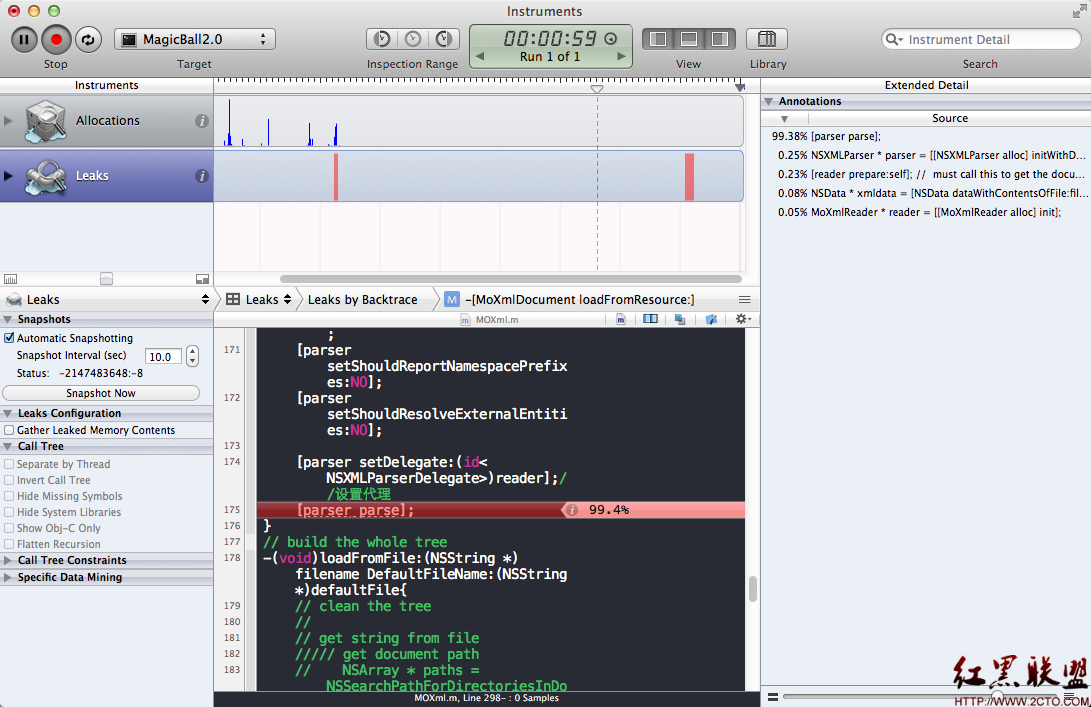WWDC2012发布了iOS6,同时为Objective C带来了一些新特性以简化编程。下面是这些新特性,需要XCode4.4及以上版本支持:
1.方法的申明顺序不再要求
在方法里面可以调用在后面申明的方法,编译器会帮助查找方法的申明,顺序不再要求。如下:
@inte易做图ce SongPlayer : NSObject
- (void)playSong:(Song *)song;
@end
@implementation SongPlayer
- (void)playSong:(Song *)song {
NSError *error;
[self startAudio:&error];//XCode4.4以前会提示方法未定义,XCode4.4以后可以放心使用
...
}
- (void)startAudio:(NSError **)error { ... }
@end
2.枚举支持强类型
XCode4.4以前定义枚举使用如下方式,相当于定义了类型为int的枚举类型。
typedef enum {
NSNumberFormatterNoStyle,
NSNumberFormatterDecimalStyle,
NSNumberFormatterCurrencyStyle,
NSNumberFormatterPercentStyle,
NSNumberFormatterScientificStyle,
NSNumberFormatterSpellOutStyle
} NSNumberFormatterStyle;
// typedef int NSNumberFormatterStyle;
XCode4.4以后可以为枚举指明强类型,这样在赋值时会有强类型限制(需要在Build Setting开启Suspicious implicit conversions)。定义如下:
typedef enum NSNumberFormatterStyle : NSUInteger {
NSNumberFormatterNoStyle,
NSNumberFormatterDecimalStyle,
NSNumberFormatterCurrencyStyle,
NSNumberFormatterPercentStyle,
NSNumberFormatterScientificStyle,
NSNumberFormatterSpellOutStyle
} NSNumberFormatterStyle;
或使用NS_ENUM宏来定义
typedef NS_ENUM(NSUInteger, NSNumberFormatterStyle) {
NSNumberFormatterNoStyle,
NSNumberFormatterDecimalStyle,
NSNumberFormatterCurrencyStyle,
NSNumberFormatterPercentStyle,
NSNumberFormatterScientificStyle,
NSNumberFormatterSpellOutStyle
};
3.默认属性合成
@inte易做图ce Person : NSObject
@property(strong) NSString *name;
@end
@implementation Person {
NSString *_name;//这句可以省略,XCode很早就可以了
}
@synthesize name = _name;//XCode4.4以后,这句也可以省略,XCode默认合成带下划线的成员变量
@end
即可以简化为:
@inte易做图ce Person : NSObject
@property(strong) NSString *name;//ARC开启,否则需要自己release
@end
@implementation Person
@end
4.创建NSNumber的新语法
XCode4.4以前的创建方式:
NSNumber *value;
value = [NSNumber numberWithChar:'X'];
value = [NSNumber numberWithInt:12345];
value = [NSNumber numberWithUnsignedLong:12345ul];
value = [NSNumber numberWithLongLong:12345ll];
value = [NSNumber numberWithFloat:123.45f];
value = [NSNumber numberWithDouble:123.45];
value = [NSNumber numberWithBool:YES];
XCode4.4以后可简化为:
NSNumber *value;
value = @'X';
value = @12345;
value = @12345ul;
value = @12345ll;
value = @123.45f;
value = @123.45;
value = @YES;
XCode4.4以前,使用语句创建NSNumber:
NSNumber *piOverSixteen = [NSNumber numberWithDouble: ( M_PI / 16 )];
NSNumber *hexDigit = [NSNumber numberWithChar: "012345679ABCDEF"[i % 16]);
NSNumber *usesScreenFonts = [NSNumber numberWithBool:
[NSLayoutManager usesScreenFonts]];
NSNumber *writingDirection = [NSNumber numberWithInt:
NSWritingDirectionLeftToRight];
NSString *path = [NSString stringWithUTF8String: getenv("PATH")];
XCode4.4以后可以通过”()”方式创建:
NSNumber *piOverSixteen = @( M_PI / 16 );
NSNumber *hexDigit = @( "012345679ABCDEF"[i % 16] );
NSNumber *usesScreenFonts = @( [NSLayoutManager usesScreenFonts] );
NSNumber *writingDirection = @( NSWritingDirectionLeftToRight );
NSString *path = @( getenv("PATH") );
5.创建NSArray的新语法
NSArray* array;
array = @[ a, b, c ];
//相当于使用下面的方式创建:
id objects[] = { a, b, c };
NSUInteger count = sizeof(objects)/ sizeof(id);
array = [NSArray arrayWithObjects:objects count:count];
6.创建NSDictionary的新语法
NSDictionary *dict;
dict = @{};
dict = @{ k1 : o1 };
dict = @{ k1 : o1, k2 : o2, k3 : o3 };
//相当于如下方式:
id objects[] = { o1, o2, o3 };
id keys[] = { k1, k2, k3 };
NSUInteger count = sizeof(objects) / sizeof(id);
dict = [NSDictionary dictionaryWithObjects:objects
forKeys:keys
count:count];
7.mutable对象的创建,调用对象的-mutableCopy方法
NSMutableArray *mutablePlanets = [@[
@"Mercury", @"Venus", @"Earth",
@"Mars", @"Jupiter", @"Saturn",
@"Uranus", @"Neptune"
] mutableCopy];
8.静态容器对象的创建,使用+initialize方法
@implementation MyClass
static NSArray *thePlanets;
+ (void)initialize {
if (self == [MyClass class]) {
thePlanets = @[
@"Mercury", @"Venus", @"Earth",
@"Mars", @"Jupiter", @"Saturn",
@"Uranus", @"Neptune"
];
}
}
9.可变数组新的存取方式:
@implementation SongList {
NSMutableArray *_songs;
}
- (Song *)replaceSong:(Song *)newSong atIndex:(NSUInteger)idx {
Song *oldSong = _songs[idx];//使用[idx]访问子对象
_songs[idx] = newSong;//使用[idx]设置子对象
return oldSong ;www.zzzyk.com
}
10.可变字典新的存取方式:
@implementation Database {
NSMutableDictionary *_storage;
}
- (id)replaceObject:(id)newObject forKey:(id )key {
id oldObject = _storage[key];//相当于id oldObject = [_storage objectForKey:key];
_storage[key] = newObject;//相当于[_storage setObject:object forKey:key];
return oldObject;
}





